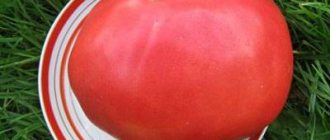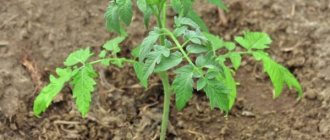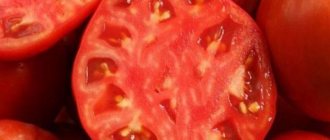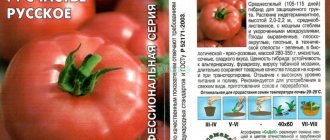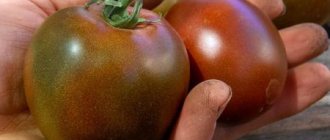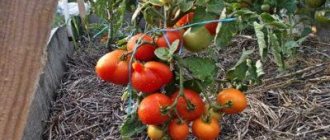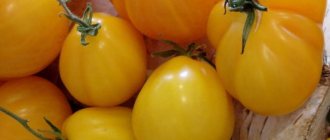Tomato varieties bred in Siberia have amazing qualities that make it possible to grow a far from cold-resistant crop in a cold region. Among yellow-fruited tomatoes, Golden Domes are held in special esteem. The variety has long been known and loved by gardeners. It was included in the State Register of Breeding Achievements of Russia in 2005, although it was grown long before this event. The authors of the well-recognized tomato were V.N. Dederko, S.V. Ugarova and T.N. Postnikova. Due to its high adaptive qualities, the State Register recommends growing the variety in open ground, and any region of the country is suitable for cultivation.
Description of the variety
To obtain complete information about the species, a summer resident needs to study the characteristics. This information makes it possible to get an idea of the variety. Understand what a person needs in order to grow it on the plot.
Siberian selection
Manufacturers develop varieties that are adapted to harsh growing conditions. These include unfavorable weather conditions, short summers, sudden changes in weather, and more.
Appearance of the plant
Golden Dome tomatoes are grown in open and protected ground. The plant type is determinate. The maximum height of the crops is 1.5 m. The leaves are medium, the inflorescence is complex.
Fruit characteristics
The fruits are shaped like a heart. The fruit color is yellow-orange. The weight depends on the care and formation of the bushes. Maximum weight 800 g, average weight 400 g. The taste is excellent.
The best and worst varieties of tomatoes: which ones to plant and which ones to avoid?
We recently celebrated the New Year and it would seem that spring is still far away, but the gardener’s heart is already beating faster in anticipation of the planting campaign. But what varieties of tomatoes should you choose so that the coming year’s harvest does not disappoint?
Last year, the clear favorites when choosing seeds were tomatoes: Honey Drop, Black Moor, Mazarin, King of the Market2, Sanka, which justified themselves with a bountiful harvest. Perhaps only Mazarin disappointed many by not showing the declared qualities.
Feedback from gardeners on tomato yield results will give you an idea of many varieties of tomatoes. As a result of the analysis, you yourself will be able to compile for yourself a list of seeds that you will purchase for planting.
Didn't like these tomato varieties
- Atlantis
(SibSad) - terrible small (50-60 gr.) sour, on a powerful and strong trunk, although it didn’t hurt. - Boni MM
- I didn’t like it at all, neither in taste nor in quantity, and I didn’t have it at all early. - Bobcat and Slot
are productive, but the taste is the most common, market one. - Boogie - woogie
- not early and tasteless. - Yellow cherries
- tasty, sweet, lots of them, but very small and almost all of them were cracked - Irishka F1
(Russian vegetable garden) - cold-resistant, unpretentious, so-so, nothing special. - Koenigsberg red
- suffered from blossom end rot, low yield. - A Moscow delicacy
- very tasty, meaty icicles. Not very productive. Sick with Koenigsberg from apical rot - Honey-sugar
(SibSad) - “oak” store-bought tomatoes, although yellow in color, lasted the longest on the windowsill, but the taste changed for the worse. - The mandarin duck
was not impressed, in my opinion the honey drop is better, although the tomato is half the size. - Mazarin
was not impressed. - Eagle Heart
- I got sick first, I didn’t get any tomatoes. - Pink Leader
is the worst variety of this year in terms of fruit taste and yield. - Siberian Lights
- large cream, but empty inside - Timofeich
- fruitful, sweet and sour taste - Wonder of the world
- a lot of tomatoes, bears fruit for a long time, is unpretentious. Beautiful fruits with a spout. The taste is sour both in salads and in preparations. In salads, the juice is white-yellow-watery. LET'S CLEAN UP! - Jason
(Zedek) - tasteless
Advantages and disadvantages
The plant has positive and negative characteristics. The summer resident will have to evaluate the merits of the tomatoes and the quality of the plants themselves.
Advantages:
- Taste characteristics.
- The best variety for dietary nutrition.
- Does not contain acid.
- Stores well unripe.
Flaws:
- Requirement for formation.
- Prone to cracking.
- Unsuitable for canning entirely.
Experienced summer residents eliminate shortcomings by showing ingenuity.
Advantages and disadvantages
The main advantage of the variety is its excellent taste, in particular, the almost complete absence of acid, which causes heartburn in many people. Thus, “Golden Domes” are optimally suited for people suffering from high stomach acidity and following a diet.
The disadvantage is that irregular heavy watering leads to cracking of the skin. The reason here is that the supply of copious amounts of water causes the tomatoes to quickly gain additional weight. The skin of tomatoes does not grow as quickly as their flesh, which can lead to its rupture.
Agricultural technology
Proper cultivation is the key to the future harvest. Fulfilling all requirements will allow you to get a high yield.
Preparing and planting seeds
Before you plant the seeds, you need to check them. Dilute 1 tbsp in 1 liter of water. spoon of salt, pour the seeds there. Those that float are not suitable for landing. The rest are washed and dried.
For 30 min. the seeds are dipped in a solution of potassium permanganate. Then rinse with warm water and dry.
For planting, mix the soil:
- 1 part of turf land;
- 2 parts humus;
- 1 part river sand.
Water with a weak solution of potassium permanganate and make furrows at a distance of 5 cm, 2-3 cm deep. Sow dried planting material. Sprinkle with earth and cover with polyethylene. Place in a warm, dark place until sprouts appear.
See also
Description of the hybrid tomato variety Izobilny f1 and cultivation in open ground
Read
Care and planting of seedlings
Plants require high-quality care, as the foundation for the future harvest is laid. Loosening is carried out after each watering.
Diluted manure and complex mineral compounds are used as fertilizers.
When the second true leaf appears, pick the tomatoes into separate containers. Summer residents advise using peat pots. This way the root system is not disturbed when transplanting to a permanent location.
The date of planting in a greenhouse or soil is determined by the summer resident independently. The bed is prepared in advance, watered and holes are made. The distance between bushes is 40 cm, between rows 50 cm.
How to water
Watering the seedlings is carried out in a timely manner, as the top layer dries. You can’t overwater, but the plants shouldn’t dry out either.
At first, they irrigate the ground with a spray bottle, so the roots of fragile seedlings are not washed out. Then water carefully between the grooves. Make sure that the roots are not eroded.
Conditions for maximum fruiting
Following simple rules will help you get the maximum yield:
- correct landing;
- selection of location and soil;
- implementation of agricultural techniques;
- formation of bushes;
- introduction of fertilizing;
- timely watering;
- mulching and loosening.
Compliance with planting requirements and recommendations of experienced summer residents leads to an increase in yield.
Transfer rules
Usually seedlings are transplanted at the age of 55-60 days. During this period, the sprouts have time to grow a good root system and above-ground part.
Before planting, tomatoes are accustomed to fresh air and sunlight - they are regularly taken outside in the morning and kept for several hours. Two days before transplanting, the plants are left to spend the night in the fresh air.
Preparing the bed
Tomatoes love loose, light, soil with a neutral pH level. Choose a place where legumes, cabbage of any variety and root vegetables previously grew.
The bed is prepared in the fall - it is cleared of plant debris, weeds, sprinkled with organic matter (a bucket of compost or humus) and mineral fertilizers (3 kg of wood ash and 100 g of superphosphate and potassium sulfate). If deoxidation is necessary, add 300 g of slaked lime or chalk. Then they carry out digging, leveling and watering.
In the spring, 2 weeks before the planned transplantation of bushes, the area is sprayed with a urea solution - 2 tbsp. l. for 20 liters of water. This component improves the nutritional composition of the soil and kills all kinds of parasites that have survived the winter in the ground. After irrigation, the soil is dug up and leveled.
Disembarkation scheme
The holes are prepared according to the 50x60 cm pattern. For a bed of 1 m², 5-6 bushes are enough. Each hole is spilled with 1 liter of water. After absorbing moisture, the roots are lowered, sprinkled with earth, lightly compacted and hilled to ensure the stability of the seedlings.
In the first days, seedlings are very sensitive to sunlight and night temperature. Therefore, at midday it is covered from the sun, and in the evening it is covered with film.
Bush care
After planting in open ground or a greenhouse, you should properly care for the plants. Water as needed, Gold domes are prone to cracking. Therefore, watering is rationed. Moisturize regularly and abundantly, preventing it from drying out. Plants need supports, the bushes are tall, they are tied to stakes. The brushes also break off under their own weight. Therefore, they are tied individually.
Summer residents recommend forming plants into 2-3 stems. There is no need to remove the growing point in open ground. Tomato Golden Domes does this on its own. Loosen after each watering. This ensures access to oxygen, reduces the number of weeds and retains moisture in the soil.
Some vegetable growers practice mulching using sawdust, rotted straw and other available materials.
It is recommended to fertilize tomatoes 3-4 times per season:
- a week after transplantation to a permanent place;
- during flowering;
- fruit formation;
- before ripening.
Use minerals and organic matter in moderation. Overfed plants form green mass without paying attention to the ovary.
How to grow tomatoes
The seedlings are ready for planting in a permanent place in 50 - 55 days. Fertilizers such as humus, compost or peat are first added to the soil.
Tomatoes need to be planted in two rows, with the seedlings of the first row in relation to the seedlings of the second row placed in a checkerboard pattern. The distance between bushes is at least 50 cm, and between rows - 40 cm.
Watering is most important during the flowering and fruit set stages. Without a sufficient amount of moisture, pollination will not occur, and those fruits that have time to set will not gain weight. Water tomatoes at the root, which prevents fungal diseases.
Water 2 times a week in the evening, 2 liters of water for each seedling. A good conductor of water is an ordinary plastic bottle without a bottom. It is installed at a shallow depth in the root zone and filled with water, which gradually penetrates to the roots.
After watering, weeding and loosening of the soil is necessary. These simple steps not only provide oxygen access to the roots, but also help in pest control.
Mulching beds with straw is another preventive measure that keeps beds moist longer.
A determinate plant requires obligatory garter, since heavy fruits can break not very powerful stems. Vertically stretched ropes or wooden stakes serve as a strong support.
In addition to the garter, mandatory stepsoning is required.
Pinching involves removing additional stems that appear in the axils between the main trunk and the tomato leaf. In one season there are up to 50 stepsons on a plant. If they are not removed, then the excess of branches will not allow the fruits to gain the proper weight.
Vegetables planted in street beds are grown in 3-4 fruit stems, and in a greenhouse - in 1 stem. Growing in a greenhouse involves dense planting and tying to a rope support.
The formation (stepchildren) of a culture depends on the region in which it grows. In the northern regions, the best fruiting rate is observed when growing in 2 trunks, in the southern regions - when growing in 3-4 trunks.
To limit plant growth, pinch the top.
To achieve maximum fruiting, they resort to specialized preparations. For example, boric or succinic acid increases the number of ovaries in each cluster, and growth stimulants (Biostin, Rhizome) help to quickly gain root mass.
Diseases and pests
Despite its Siberian character, the plant is susceptible to diseases such as late blight, verticillium wilt, and blossom end rot.
Fungicidal agents help in the fight against these diseases.
Calcium nitrate successfully combats blossom-end rot by watering and spraying the plant.
In the fight against late blight, the main role is given to Bordeaux mixture or Fitosporin. These drugs destroy the cause of the infection, and the affected parts of the plant should be burned. Copper sulfate is used as a preventive measure against late blight.
As for insects, they are not averse to taking over vegetable beds and causing considerable harm to plants. These are known to every summer resident: mole crickets, spider mites, gnawing cutworms, Colorado potato beetles, and slugs.
Beds covered with wood ash and tobacco dust save tomatoes from pests, as does regular inspection of the bushes.
Slugs and Colorado potato beetles are collected by hand, and mole crickets are scared away from the beds by pungent odors.
Spider mites live in a greenhouse, so there is a need for regular ventilation in order to destroy the conditions for the existence of the parasite.
Insecticides also help protect against parasitic insects. But remember that treatment with them is possible 1 month before fruiting.
Diseases and pests
Disease prevention is carried out by summer residents themselves. Planting technology and care features are observed.
Golden Dome tomatoes are resistant to diseases characteristic of the crop. For prevention or after detecting signs, they are treated with chemicals. After flowering, it is undesirable to use insecticides and fungicides, since the substances will remain in the fruits and then enter the human body. They use traditional methods of fighting insects and diseases.
See also
Description of the Tretyakovsky tomato variety, cultivation and pest control
Read
Farmer reviews
The opinions of vegetable growers about the taste sensations of Siberian tomatoes are varied .
For some it is a honey sweetness, others perceive a grape note, others talk about a citrus aroma. Perhaps the taste is influenced by different growing conditions of the culture, or maybe it’s a matter of everyone’s individual imagination.
Gardeners note a high quantitative indicator , which, of course, cannot be disappointing, despite the short shelf life of the fruit. They unanimously confirm the cold resistance of the crop, but there are two opinions about its susceptibility to diseases: some have vegetable plants that stand healthy and beautiful all summer, while others spend part of the season fighting infections.
Anastasia, Chelyabinsk: “I love large tomatoes. I have always grown Bull's Heart, but after meeting the Golden Domes, I don't look at other species. The care is simple, the results are stunning.”
Vasily, Novosibirsk: “I planted tomatoes in open ground, to be honest, I didn’t expect any special results in our climate. However, I was pleased with the harvest, and the fruits themselves are large, sweet and good in salads.”
Use of fruits
The large-fruited nature of tomatoes does not allow the use of vegetables for whole-fruit canning. Therefore, summer residents use Golden Domes for:
- juices;
- seasoning dishes;
- fresh salads;
- refilling preserves in winter;
- preparing winter platters, where tomatoes are cut into slices, and much more.
The use of tomatoes in home cooking depends on the imagination of the housewife and the wishes of the household.
Harvesting and application
Fruit ripening begins in August .
Beds with ripened golden tomatoes in the shape of church domes look very beautiful. Tomatoes should not be allowed to overripe as they may crack. Vegetables can be collected unripe; they will gain color on their own. Do not forget that ripe vegetables of this variety cannot be stored . The harvest is processed for winter harvesting, and some is left for fresh salads. Moderately juicy and dense, they perform well in lecho, juice, adjika and ketchup. They look original in fresh salads, complementing other vegetables perfectly.
For preparations, select smaller tomatoes so as not to cut them into several parts. And if you dilute orange tomatoes with red ones, then such a technique will be a worthy decoration for any feast. The fruits retain their taste well in barrel pickling.
The absence of tomato juice in fruits indicates a low acidity content , which allows the use of ripe vegetables for dietary nutrition.
Analogs
Golden Domes have several similar varieties and hybrids. Plants with similar characteristics and qualities.
Domes of Russia
An early large-fruited tomato, the height of an adult plant is 2.5 m. 3-4 fruits are formed in one cluster. The average weight of one tomato is 0.5 kg, pink in color. If planting and care standards are observed, up to 15 kg of tomatoes can be harvested from 1 bush.
Plant care involves following standard agricultural practices. Garter and formation of bushes are required.
Honey domes
Low bushes are productive. During mass ripening, they are covered with many medium-sized fruits (maximum 150 g), yellow in color. No gartering or shaping is required; the plants are unpretentious in care. The yield from one bush is 2.5-3 kg.
Pink Domes F1
The hybrid ripens early. Pink, heart-shaped tomatoes reach a size of 0.25 kg. The peculiarity of the variety is that the tomato does not crack. The harvest volume with proper care is 25 kg per 1 m2.
Ob domes
The plants are low, maximum size 50 cm. The fruits are red and large. The weight reaches 250 g. 1 bush produces 5 kg of fruit, provided that all planting and care requirements are met.
Russian domes
Early ripening, tall tomatoes. The plant reaches 2.5 m in height. The fruits are red, up to 0.2 kg.
Red Dome
Ready for use 3 months after germination. The bushes are small, up to 0.7 m. With proper care, a summer resident receives 3 kg of vegetables from 1 plant. Minimal maintenance, no shaping required.

